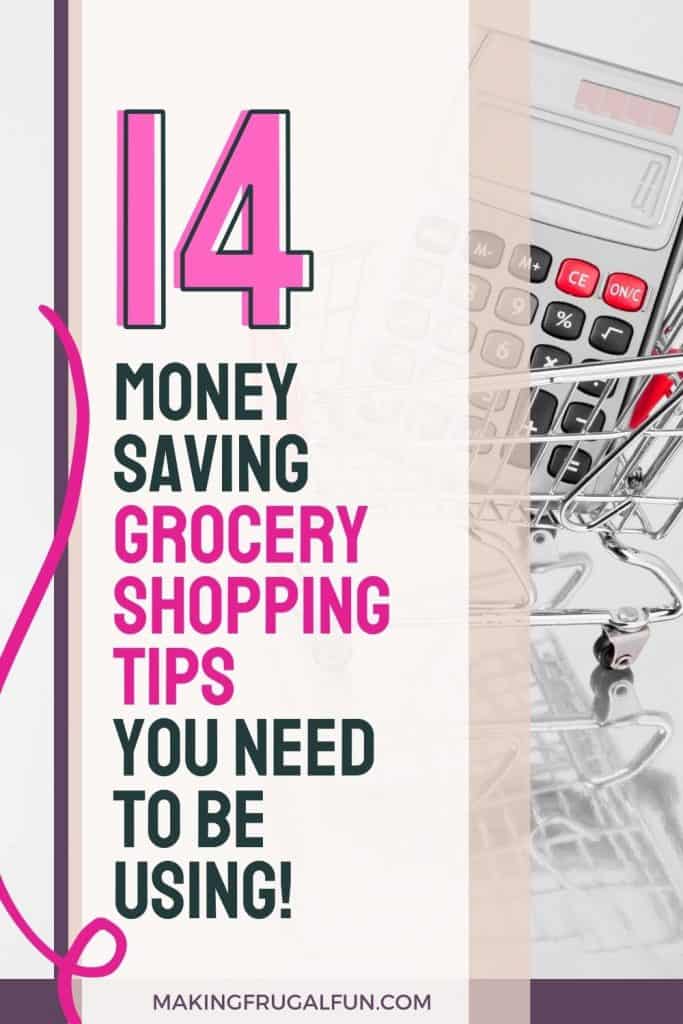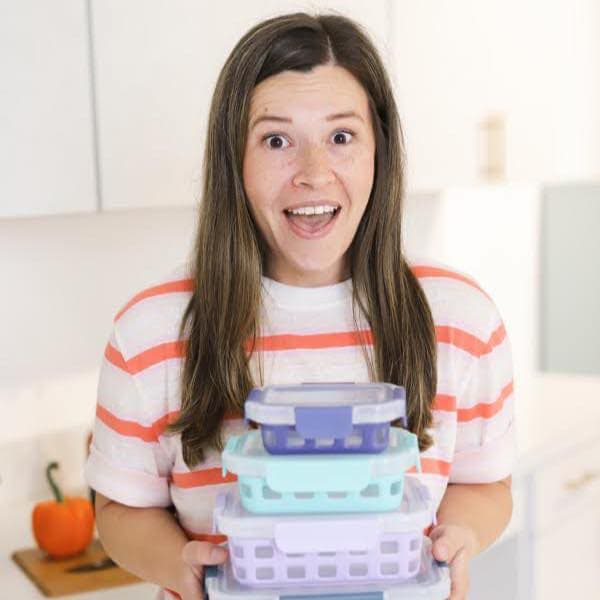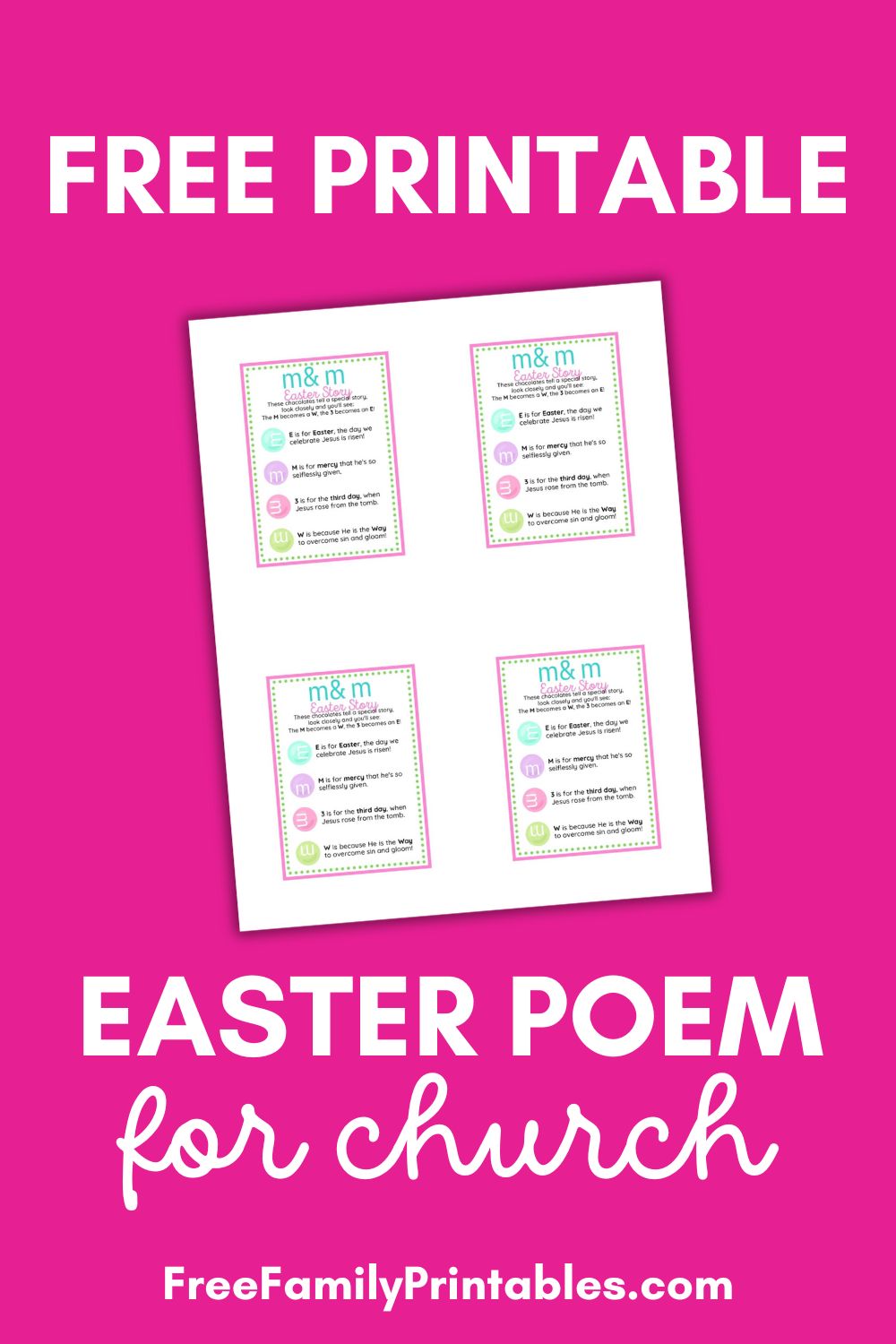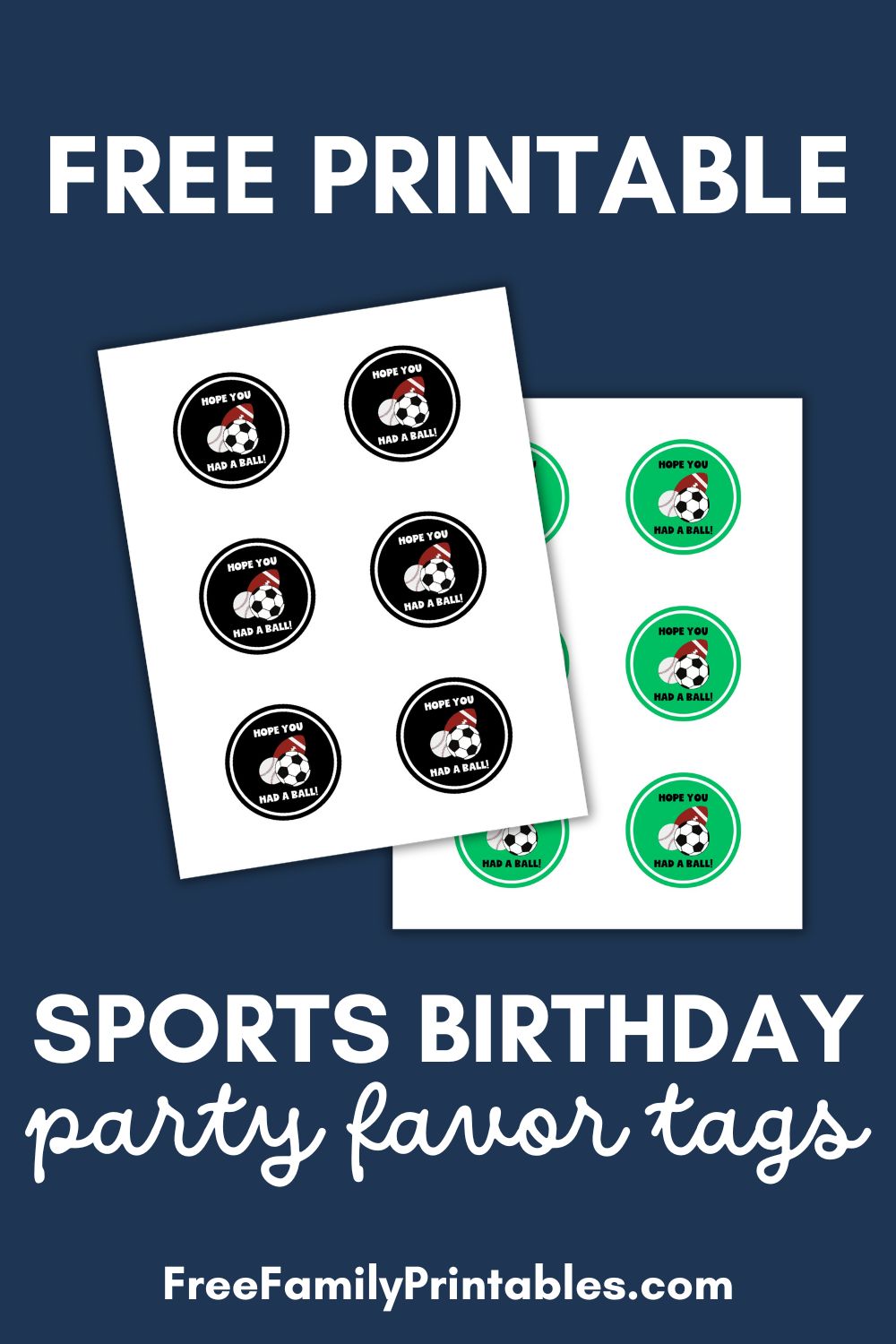If you’re working on your budget, you might be wondering how to save money on groceries.
In fact, most people overspend on food each month. Whether it’s lack of planning, not paying attention, or struggling with impulse buys, sticking to your grocery budget is difficult.
When we began our debt free journey at the beginning of 2019, the first thing we did was analyze our spending, and that’s when we realized we were easily spending $1,000 to $1,500 every month on food!
The first thing that had to go was restaurants and fast food, but even then our lack of planning and aimless wandering of the grocery store aisles, left us spending way more than we were comfortable with on our new found financial journey.
Once we decided that eating at home more often was the way to go, we still needed to work on reducing our grocery spending.
I’m not much of a couponing mom, but I’ll definitely use a store coupon if it’s easy to access! I’m much more likely to stick to generic store brands, and use Rebate apps like Fetch Rewards or Ibotta to save a few extra dollars on each grocery trip.
However, I’ve found that the best way to save money on our grocery bill is to make sure we have a solid meal plan in place to prevent weeknight dinner decision fatigue.
That’s why we plan out an entire month of meals in advance and rotate our meal plan each month. There’s no question about what we are eating each night, and we cut out the exhaustion of deciding what to eat each week.
Once we have our meal plan in place all we need to do is create our grocery shopping list and stick to it!
You can see an example of our monthly meal plan and try it out for yourself by filling out the form below.
Meal planning and shopping with a list are two of my favorite “no-fail” ways to save money at the grocery store, but that doesn’t mean there aren’t a few other tips and tricks up our sleeves to save big on food.
Here are a few more ways you can make sure to save money on groceries each month.
Shop Based on Price Per Unit
When you’re shopping, it can be tempting to simply look at the lowest priced item and grab that one. However, just because an item is cheaper as a whole, does not necessarily mean it’s the best deal.
You might notice that a larger bulk item is actually cheaper when you compare the item on it’s price per unit, even thought the total price will obviously be more. You might be able to save more money in the long run, especially if it’s a non perishable item like dry beans, pasta, or household supplies like laundry detergent.
One example of this is laundry detergent at Costco. I always assume that the Kirkland (generic Costco) brand will be the cheapest, but instead I always find that when I compare price per unit, the Tide All Free & Clear actually ends up being the better deal.
It’s always best to check price per unit when shopping, just to make sure you aren’t missing a deal!
Save Money By Buying Store Brands
I remember going over to friend’s houses when I was little, and thinking they were so fancy if their parents bought all the name brand snacks!
Now that I’m footing the grocery bill, I know that there’s really minimal difference in taste and quality of generic store brand items versus name brand products.
That’s not to say that you should always buy the generic item. Always make sure you compare prices on each grocery trip.
If there happens to be a sale on the name brand, I’ve ran in to a few instances where the name brand product is actually cheaper than the store brand item. Especially if you happen across a coupon, or have an Ibotta rebate that earns you cash back or makes the item free (always check!).
However, the general rule of thumb is that generic store brand items are cheaper, and just as delicious, as their name brand counterparts.
Use Coupons
I am definitely not the coupon queen, but I always use them if I have them!
Make sure to open mail from your local grocery store and subscribe to their loyalty card.
We shop at Kroger and we receive personalized coupons, based on items we already purchase and use, every few months. It’s great to get coupons for things you were already planning to buy!
One thing you have to be careful about with coupons, is making sure you’re not buying extra things you don’t need…just because you have a coupon! If you don’t need it, it’s not saving you money.
Most people don’t use coupons because they seem complicated, but you don’t need to be extreme to save big! In fact, shoppers using coupons save an average of $30 to $50 per week according to The Balance Everyday. Totally worth it in my opinion!
With the combination of coupons and our loyalty shopping card, we definitely see a savings of at least $20-$30 per shopping trip.
Only Shop from a Shopping List
If I had to choose only one thing on this list that you absolutely must do to save more money on your grocery budget each month, it would be to only make a list and stick to it…NO MATTER WHAT!
Grocery shopping with a list puts you back in control!
Stores know how to market to the consumer. They are total pros at getting you to buy more than you were planning on. Whether it’s putting the most expensive brand name items at eye level, or placing the most delicious snacks in reach of your toddler, if you don’t have a plan, you’ll end up spending way more than you want!
The best thing you can do at the beginning of each week, is sit down, plan out all of your meals, and make a grocery list to keep you on track.
We take things a step further and plan out all of our meals for an entire month. This way there is no decision fatigue with trying to figure out what to eat.
We simply consult the meal plan, then browse the pantry to see what we are missing. Since we eat many of the same meals often, we can buy in bulk so we usually have most of what we need in stock.
Buy in Bulk
We love to buy in bulk to save money on groceries.
Since we plan out our meals a month in advance, and rotate our meal plan for several months at a time, it really benefits us to make purchases in bulk. We know we will use it all up eventually!
Even if you have a small family, buying in bulk can be useful, especially if you eat similar meals or cook using many of the same ingredients.
A few items that you should always buy in bulk include:
- Coffee
- Paper Products (paper towels, toilet paper, paper plates)
- Diapers
- Pet Food
- Batteries
- Laundry detergent
- Pasta
- Rice
- Cheese
- Protein Bars
- Cleaning supplies
- Toiletries (shampoo, conditioner, soap)
Don’t Buy Simply Because Something is On Sale
Something that is definitely difficult for me to acknowledge, is that just because it’s on sale, doesn’t mean it’s a good deal!
I love to shop a good sale, and when I see those big percentage markdowns I get super excited to throw it in my cart.
However, it’s important to check the sale price against other brands as it’s possible that you could get the item for an even better deal if you buy a store (generic) brand, or shop in a different season, or buy in bulk.
It’s also important to make sure it’s something you need. If it’s not on your pre planned shopping list, then you probably don’t need it, making it a not so good deal after all.
Don’t allow sale items to trick you in to spending more than you originally planned.
Buy Seasonal Fruits and Veggies
Have you ever tried to buy watermelon, strawberries, or blueberries in the fall or winter months? They are way more expensive!
It’s so much cheaper to shop seasonally when you are buying fruits and vegetables. Even better if you can get them fresh from a farmer’s market and support local produce.
When is the best time of year to buy certain fruits and vegetables? I love to consult the US Department of Agriculture’s seasonal produce guide when meal planning, so I know I’m buying the most fresh and best priced produce year round.
Shop Online
One of our family’s favorite grocery saving secrets is that we input our grocery list online before we even set foot in the store. This allows us to get an idea of what we will be spending once we check out.
We aim to stick to a budget of $100/week for our family of five, and creating an online shopping list FIRST, helps us stick to this.
If you are someone that really struggles with impulse spending, ordering online and selecting grocery pick up can be a real budget life saver for you!
The last couple of years have made online grocery shopping and delivery almost as easy as ordering a pizza! You can have your groceries delivered, or simply pull in to the parking lot and have a nice associate pack your groceries right up in to your car for you!
This is a serious convenience for those of us with little kids, but also can be helpful for busted budgets.
You can visit your local grocery website to see if they do delivery or store pickup, or use a service like Instacart, Shipt, or Amazon Fresh. If you have special dietary concerns, Thrive Market is an online grocery store where you can shop via categories like keto, diary free, gluten free, and more!
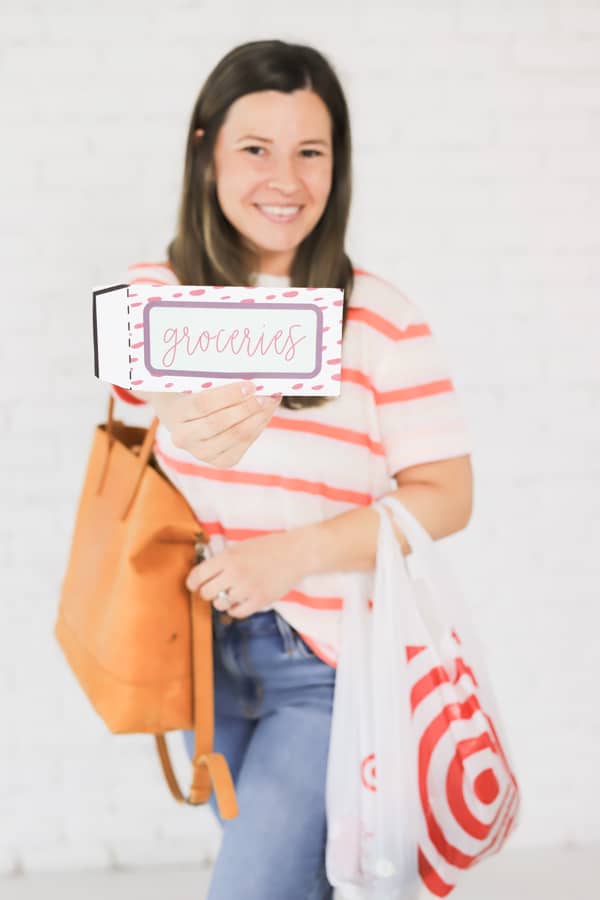
Use Cash Envelopes
Have you ever considered using cash envelopes to keep you on track when grocery shopping?
Paying with actual cold hard cash is definitely considered “weird” in our culture today. We want everything to be fast, easy, and touch free!
When deciding if switching to a cash budget will help save you more money on groceries, here is something to consider:
You are more likely to overspend when using a credit or debit card
There is an emotional attachment to using cash. When you can actually feel the money leave your hands, you will be more conscious about your spending.
According to a statistic from Shift Processing, consumers spend as much as 83% more when using a card versus handing over their cash.
Think using cash envelopes sounds complicated? You can read my full guide to using cash envelopes here.
Make sure to grab my free budget planner and printable cash envelopes by filling out the form below!
Don’t Shop When You’re Hungry
I think when I was in college and before I was married with kids, I would just wait until I was absolutely starving to go grocery shopping! Ha ha!
I would come back with tons of sweet and salty snacks, and rarely anything to create a meal.
Although I’m much better about shopping at a planned time each week, I still struggle with impulse spending if I rush out the door without anything to eat.
I find myself much more effective at sticking to the budget if I head to the store right after a meal, and that goes for the kids too!
You can prevent a lot of toddler meltdowns if you make sure they are fed before you head out for a long grocery store trip.
Use a Smaller Cart
You can’t buy it, if you can’t carry it out of there, right?!
Although this tricky tip, might not work on your weekly grocery store shopping trip, it is helpful if you are running in to the store to buy one or two items (think bread and milk).
If you are someone that struggles with impulse purchases (ie. going to Target for eggs, and leaving with $250 of home decor goodies), shopping without a cart at all…or just grabbing a small basket…might be the perfect alternative for you.
Shop with a Calculator
Shopping with a calculator can be really helpful when you’re struggling to stick to your grocery budget. Especially if you are new at using cash envelopes, or new at budgeting in general.
Using a calculator could also be a great way to get your kids involved (and keep them busy) while shopping!
Simply keep a small calculator with you in your purse or car so you don’t forget it on your grocery trips, and keep track of each item as you shop to make sure you are on (or under) budget.

Use a Discount App
I love using grocery shopping discount apps as a fun and easy alternative to couponing. The two I use most frequently are Ibotta and Fetch Rewards, but there are new ones popping up all the time in the app store.
Grocery shopping discount apps are kind of like couponing in reverse. You do your shopping and then scan your receipts when you get home to collect your cash back rewards.
Cash back reward apps are also a nice tool to have if you don’t use credit cards (like us). You can still have the excitement of earning cash back without going in to debt.
Ibotta
Ibotta is an excellent way to save money on groceries. I’ve been using this app for a few years and have earned hundreds of dollars in cash back rewards.
You can sign up here and get an extra when you scan your first receipt.
Read more: How to use Ibotta for cash back on groceries
Fetch Rewards
Fetch Rewards is a cash back reward app similar to Ibotta but I find it to be a little easier to use. You don’t have to “add deals” to your app before scanning your receipt, you just scan and earn points! Simple!
Sign up here for Fetch Rewards and start earning rewards when you shop for groceries.
Save Money on These Products
Dried Beans
Beans are a cheap and easy food item to incorporate in to recipes. You can save even more money if you use dried beans as opposed to canned beans.
Rice
Rice is also an excellent choice to use in a lot of recipes to get more bang for your buck. You can add rice to almost any meat or vegetable to quickly make a hearty meal for less.
Recipe Ideas: 19 Beans and Rice Recipes to save money
Dried Pasta
You might think it’s cheaper to make your own pasta from scratch, but it’s actually pretty cheap to buy dry pasta in stores. Stick to generic store brands to save more, and buy in bulk when possible. You can also extend your pasta and waste less if you measure portion sizes when cooking and serving.
Peanut Butter
The best way to save money on peanut butter is to buy in bulk. I always try to wait to buy the huge double pack of Jif peanut butter at Costco. It ends up being an amazing deal!
If I need peanut butter and can’t find it on sale, I get the generic store brand which is pretty cheap.
Don’t fall for the convenience of the individually packaged cups! I know they are so perfect for packing in lunches, but it’s much cheaper to buy in bulk and use reusable containers to individually portion the peanut butter on your own.

You CAN save money on grocery shopping! It just takes a little planning and self control (which I know isn’t always easy in our busy exhausting lives).
Make sure you fill out the form above this paragraph to grab my free meal plan and make meal planning (and saving money on food) a little bit easier!
I hope you found these 14 tips to save money on groceries helpful, and let me know your favorite grocery saving tips!
